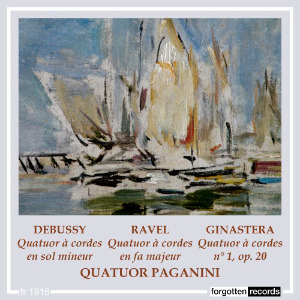
Claude Debussy (1862-1918)
String Quartet in G minor, Op. 10 (1893)
Maurice Ravel (1875-1937)
String Quartet in F major (1902-03)
Alberto Ginastera (1916-1983)
String Quartet No.1, Op.20 (1948)
Paganini String Quartet
rec. 1956-58
Forgotten Records FR1916 [69]
The long-established pairing of the Debussy and Ravel quartets spawned a large number of recordings in the 50s and 60s made for an equally large number of labels. This one was made in 1958 for Kapp by the Paganini Quartet wielding their Stradivari once owned by Paganini – hence the name of the quartet.
Formed in 1946 by ever-present first violinist Henri Temianka and cellist Robert Maas – who died in 1948 – the group never quite had a settled personnel. By 1958 Charles Libove had taken the second violin chair and David Schwartz was violist. Lucien Laporte was cellist. Their Debussy is played with dazzling elan, setting off much faster and with more calibrated rhythmic impetus than the Loewenguth Quartet’s 1962 recording for Vox. With rich chording and ripe contrasts, Temianka’s expressive personality comes across vividly and he uses those expressive devices sparingly but cannily not least in the Scherzo. Their expressive generosity is shown in the very slow tempo they adopt for the Andantino, over nine minutes, where the leader’s tender phrasing over Schwartz’s accompanying line is a standout moment. The finale is taut and lithe and though it’s an extremely fast tempo, they make it work, so deft is the sense of pulse and rubato. Here, at least, the Paganini tended to evince a ‘fast movement very fast, slow movement very slow’ approach best exemplified by the Busch Quartet.
The Ravel is not a quartet that can really bear any such extremes and the Paganini conforms rather more to the template of the Galimir or, say, the venerable Capet. It’s another incisively projected, stylistically apt performance, though, with an exceptionally poised B section in the Scherzo, and some excellent textures in the slow movement.
The substantial bonus is Ginastera’s First Quartet of 1948 and recorded just under a decade later. Temianka was to be associated with Ginastera’s music in his later role as a conductor and this quartet had first been brought to his attention by the Brazilian pianist, Marisa Regules. The line-up of the group for this recording still had the original second violin, Gustave Rosseels, but violist Charles Foidart had replaced Robert Courte. This recording was made for US Decca. Ginastera’s is a splendid quartet, luxuriating in crunchy Bartókian rhythms, drivingly motoric, full of vitality and New World energy – almost quasi-orchestral in its brilliance. He makes much use of Francophile pizzicati in the Scherzo, relaxing the tempi for the poetic slow movement, which is itself ripped apart by eruptively taut episodes of sonic contrast. The finale is ‘rustico’ to great advantage. The Paganini drive into the music with finesse and technical security. It was a quartet they didn’t just record but took to the heart of their repertory. The composer is known to have admired their recording and no wonder.
There are no notes, as usual from this label, but there are internet links. Forgotten Records has clearly sourced some blemish-free copies which have been excellently transferred.
Jonathan Woolf
| Availability |  |


















